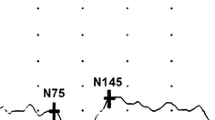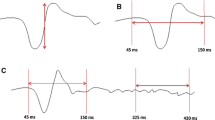Abstract
To investigate the discriminative power of pattern-reversal visual evoked potential characteristics (peak latencies and amplitude) and to test whether the addition of visual evoked potential amplitude can increase the power of the visual evoked potential in the diagnosis of multiple sclerosis, we retrospectively studied visual evoked potentials in 59 patients with definite multiple sclerosis and 126 control subjects. Two check sizes (17′ and 10′) were used. Females had significantly higher amplitudes and shorter latencies than males. N80 latency showed a gradual increase and P100 amplitude a decrease with age. P100 latency was stable between the ages of 20 and 55 years but was increased in childhood and the elderly. The significance of visual evoked potential peak latencies and amplitude in separating the two groups was investigated by means of a (multivariate) discriminant analysis. The visual evoked potential with a pattern of 10′ could be measured in 58% of patients with multiple sclerosis. The exclusive use of the P100 amplitude in the discriminant analysis resulted in a percentage of correctly classified cases of 84%, whereas for P100 and N80 latency it was 85% and 90%, respectively. With the 17′ pattern, the N80 latency yielded also a higher correct percentage than did the P100 latency. Although N80 latency is, to a greater extent than P100 latency, influenced by age, sex and size of stimulus pattern, when these influences are accounted for, the N80 latency is a more sensitive measure than P100 latency in the classification of multiple sclerosis. Combined use of latency and amplitude for discriminant analysis yielded no significant improvement of the percentage of correctly classified cases.
Similar content being viewed by others
Abbreviations
- MS:
-
multiple sclerosis
- SD:
-
standard deviation
References
Halliday AM, McDonald WI, Mushin J. Visual evoked response in diagnosis of multiple sclerosis. BMJ 1973; 15: 661–4.
Asselman P, Chadwick DW, Marsden CD. Visual evoked responses in the diagnosis and management of patients suspected of multiple sclerosis. Brain 1975; 98: 261–82.
Duwaer AL, Spekreijse H. Latency of luminance and contrast evoked potentials in multiple sclerosis patients. Electroencephalogr Clin Neurophysiol 1978; 45: 244–58.
Wilson WB, Keyser RB. Comparison of the pattern and diffuse light visual evoked responses in definite multiple sclerosis. Arch Neurol 1980; 27: 30–4.
Hume AL, Waxman SG. Evoked potentials in suspected multiple sclerosis: diagnostic value and prediction of clinical course. J Neurol Sci 1988; 83: 191–210.
Leijs MJJ, Candaele CMLJ, De Rouck AF, Odom JV A comparison of pattern reversal visual evoked potentials and contrast sensitivity Doc Ophthalmol 1991; 77: 255–64.
Allison T, Wood CD, Goff WR. Brain stem auditory, pattern-reversal visual, and short-latency somatosensory evoked potentials: latencies in relation to age, sex, and brain and body size. Electroencephalogr Clin Neurophysiol 1983; 55: 619–36.
Sokol S. Visually evoked potentials: theory, techniques and clinical applications. Surv Ophthalmol 1976; 21: 18–44.
Sokol S, Moskowitz A, Towle VL. Age related changes in the latency of the visual evoked potential: influence of check size. Electroencephalogr Clin Neurophysiol 1981; 51: 559–62.
Chu NS. Pattern reversal visual evoked potentials: latency changes with gender and age. Clin Electroencephalogr 1987; 18 159–62.
Tobimatsu S, Celesia CG, Cone SB. Effects of pupil diameter and luminance changes on pattern electroretinograms and visual evoked potentials. Clin Vision Sci 1988; 2: 293–302.
Snyder EW, Dustman RE, Shearer DE. Pattern reversal evoked potential amplitudes: life span changes. Electroencephalogr Clin Neurophysiol 1981; 429–34.
Shaw NA, Cant BR. Age-dependent changes in the amplitude of the pattern visual evoked potential. Electroencephalogr Clin Neurophysiol 1981; 51: 671–3.
La-Marche JA, Dobson WR, Cohn NB, Dustman RE. Amplitudes of visually evoked potentials to patterned stimuli: age and sex comparisons. Electroencephalogr Clin Neurophysiol 1986; 65: 81–5.
Poser CM, Paty DW, Scheinberg L, McDonald WI, Davis FA, Ebers GC, Johnson KP, Sibley WA, Silberberg DH, Tourtellotte WW New diagnostic criteria for multiple sclerosis: guidelines for research protocols. Ann Neurol 1983; 13: 227–31.
Rosner B. Statistical methods in ophthalmology: an adjustment for the intraclass correlation between eyes. Biometrics 1982; 38: 105–14.
Ederer F. Shall we count numbers of eyes or numbers of subjects? Arch Ophthalmol 1973; 89: 1–2.
Albert A, Hams EK. Differential diagnosis: two diagnostic categories.In: Multivariate interpretation of clinical laboratory data. New York: Marcel Dekker Inc, 1987: 73–132.
Swets JA, Picket RM. Evaluation of diagnostic systems: methods from signal detection theory. New York: Academic Press, 1982.
Pinckers A, Cruysberg JRM. Colour vision, visually evoked potentials, and lightness discrimination in patients with multiple sclerosis. Neuro-ophthalmology 1992; 12: 251–6.
Kurita-Tashirna S, Tobirnatsu S, Nakayama-Hiromatsu M, Kato M. Effect of check size on the pattern reversal visual evoked potential. Electroencephalogr Clin Neurophysiol 1991; 80: 161–6.
Török B, Meyer M, Wildberger H. The influence of pattern size on amplitude, latency and waveform of retinal and cortical potentials elicited by checkerboard pattern reversal and stimulus onset-offset. Electroencephalogr Clin Neurophysiol 1992; 84: 13–9.
Kriss A, Spekreijse H, Verduyn Lunel HFE, Braamhaar I, de Waal BJ, Barrett GA. A comparison of pattern onset, offset, and reversal responses: effects of age, gender and check size.In: Nadar RH, Barber C, eds. Evoked potentials II. Stoneham, Mass: Butterworth Publishers, 1984: 553–61.
Tobimatsu S, Kurita-Tashima S, Nakayama-Hiromatsu H, Akazawa K, Kato M. Age related changes in pattern evoked potentials: differential effects of luminance, contrast and check size. Electroencephalogr Clin Neurophysiol 1993; 88: 12–9.
Ghilardi MF, Sartucci F, Brannan JR, Onofrj MC, Bodis-Wollner I, Mylin L, Stroch R. N70 and P100 can be independently affected in multiple sclerosis. Electroencephalogr Clin Neurophysiol 1991; 80: 1–7.
Author information
Authors and Affiliations
Rights and permissions
About this article
Cite this article
Cuypers, M.H.M., Dickson, K., Pinckers, A.J.L.G. et al. Discriminative power of visual evoked potential characteristics in multiple sclerosis. Doc Ophthalmol 90, 247–257 (1995). https://doi.org/10.1007/BF01203860
Accepted:
Issue Date:
DOI: https://doi.org/10.1007/BF01203860




